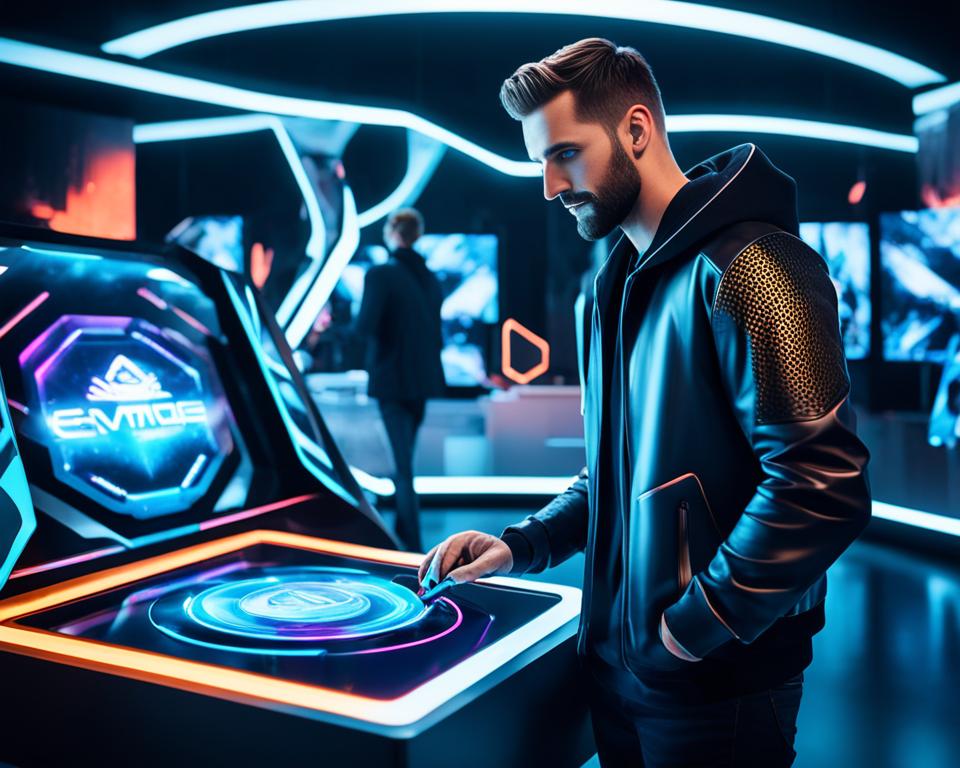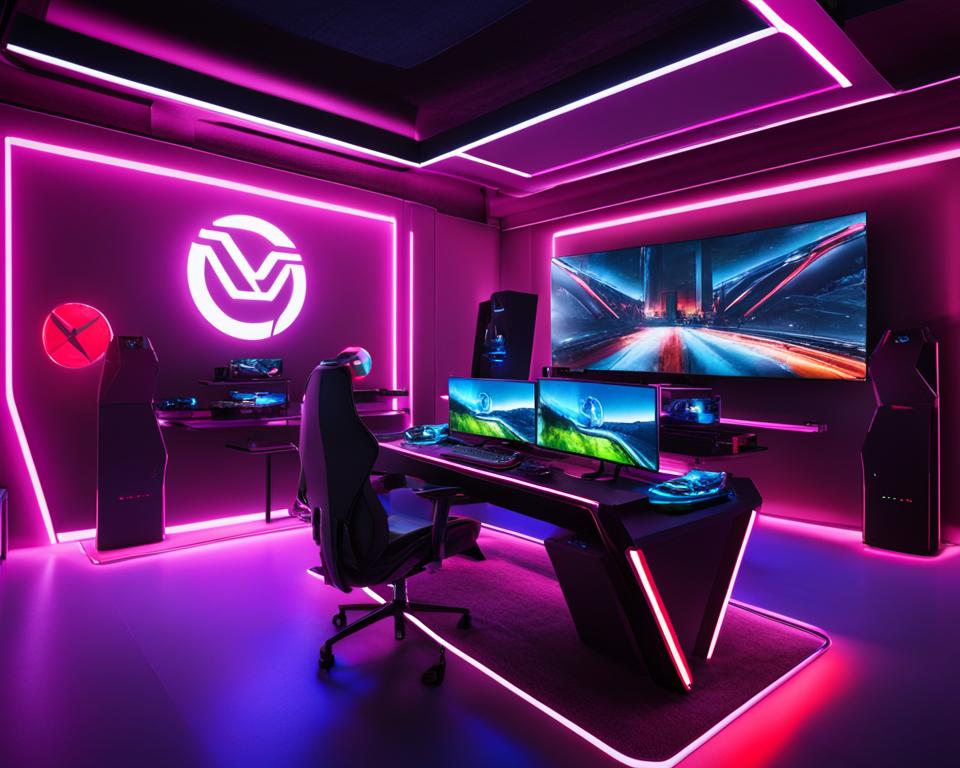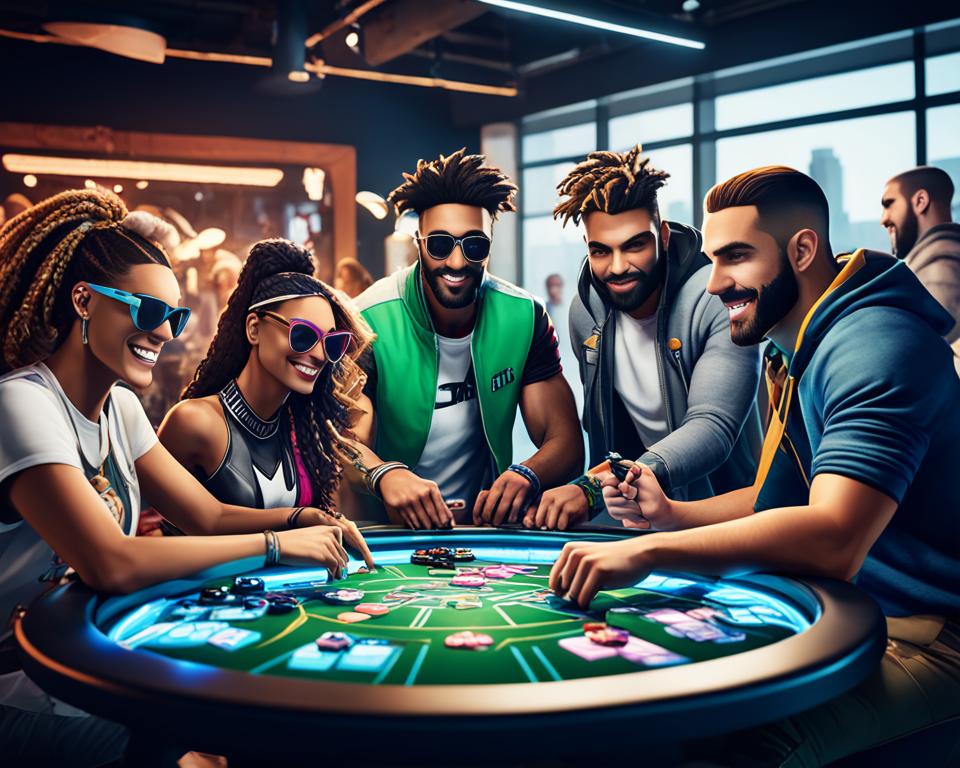Gaming has taken the world by storm, and its impact is not limited to just the gaming industry. High-end gaming has made its way into the realms of fashion and lifestyle brands, revolutionizing the way they engage with consumers and shaping their marketing strategies. The influence of gaming on these industries is undeniable, as collaborations, partnerships, and innovative campaigns are being implemented to captivate a diverse and tech-savvy audience.
In this article, we will delve into the significant influence of high-end gaming on fashion and lifestyle brands. We will explore the exciting intersection between gaming and fashion, shedding light on how the popularity of video games and gaming technologies has reshaped brand engagement and consumer behavior. From virtual fashion shows to strategic alliances with the esports industry, the gaming world is transforming how fashion is perceived and consumed.
So, join me in this exploration of the powerful influence of high-end gaming on the world of fashion and lifestyle!
Key Takeaways:
- High-end gaming has significantly influenced the fashion and lifestyle industries, transforming brand engagement and consumer behavior.
- Collaborations between high-end gaming and fashion brands have become increasingly common, resulting in innovative and captivating marketing campaigns.
- The esports industry’s rapid growth has led to strategic alliances with fashion brands, expanding their reach and engaging with a passionate fanbase.
- Mobile gaming statistics provide valuable insights into fashion preferences and shopping behaviors, enabling brands to tailor their marketing strategies effectively.
- Gaming technology updates have influenced the digital aesthetic and brand aesthetics, blurring the lines between gaming and fashion.
Video Game Market Analysis: A Look at Profitable Partnerships
The video game market has become a thriving industry, offering lucrative opportunities for fashion and lifestyle brands to enter into profitable partnerships. This section will delve into the analysis of the video game market, the impact of gaming on luxury fashion, and the successful collaborations that have emerged between high-end brands and the gaming world.
Case Study: Louis Vuitton x League of Legends Collaboration
A standout example of a profitable partnership in the gaming industry is the collaboration between Louis Vuitton and League of Legends. This strategic alliance represented a groundbreaking convergence of high fashion and esports, capturing the attention of a massive global audience. The partnership involved the creation of exclusive in-game skins and a limited-edition capsule collection, which resulted in a highly successful crossover between luxury fashion and gaming.
The Strategic Alliance Between Fashion Brands and Esports Industry Growth
The exponential growth of the esports industry has prompted fashion brands to strategically align themselves with this burgeoning sector. By forging alliances within the esports industry, fashion brands can tap into the passionate and dedicated fanbase, attracting new audiences and fostering brand loyalty. These strategic partnerships serve as a gateway for fashion brands to connect with a diverse demographic that is both tech-savvy and highly engaged.
Impact of Virtual Games on Luxury Fashion’s Visibility
Virtual games offer luxury fashion brands an unprecedented opportunity to enhance their visibility and engage with a wider audience. By collaborating with game developers, fashion brands can integrate virtual fashion items into popular games, allowing players to experience and engage with their products in a virtual environment. This form of in-game advertising provides luxury fashion brands with valuable exposure, boosting brand awareness and driving potential customers to their online and physical stores.
| Benefits of Profitable Partnerships in Video Game Market | Examples |
|---|---|
| Increased brand visibility | – Louis Vuitton x League of Legends collaboration |
| Access to a diverse and engaged audience | – Partnership between fashion brands and esports industry |
| Opportunities for in-game collaborations and virtual item sales | – Integration of luxury fashion in virtual games |
The Synergy Between Mobile Gaming Statistics and Fashion Consumer Behavior
Mobile gaming has skyrocketed in popularity in recent years, with more and more people indulging in gaming on their smartphones and tablets. For fashion brands, understanding the gaming habits of consumers is crucial in order to craft effective marketing strategies that resonate with their target audience.
The synergy between mobile gaming statistics and fashion consumer behavior reveals the significant impact that gaming has on fashion preferences and choices. Through careful analysis of gaming data, fashion brands can gain valuable insights into consumer demographics, preferences, and shopping behaviors. This information becomes invaluable in developing targeted campaigns that align with the interests and tastes of mobile gamers.
By leveraging mobile gaming statistics, fashion brands can identify the gaming genres, themes, and platforms that are most popular among their target audience. This allows them to tailor their marketing efforts to create a seamless synergy between gaming and fashion. For example, a brand targeting gamers who enjoy action-packed RPGs may collaborate with a popular mobile game developer to create limited-edition fashion items inspired by the game.
Furthermore, mobile gaming statistics can provide insights into the fashion preferences of gamers. Fashion brands can analyze data on in-game avatar customization choices, such as clothing, hairstyles, and accessories, to understand the trends and styles that resonate with gamers. This knowledge can then be used to create collections or marketing campaigns that appeal to this specific demographic.
“The synergy between mobile gaming statistics and fashion consumer behavior reveals the significant impact that gaming has on fashion preferences and choices.”
Moreover, the impact of mobile gaming on fashion choices goes beyond virtual worlds. The gaming community and culture often extend into real-life fashion choices, influencing how gamers dress and express themselves. This creates an opportunity for fashion brands to tap into the gaming culture and connect with gamers by offering clothing and accessories that align with their gaming identities.
In summary, mobile gaming statistics provide fashion brands with valuable insights into consumer behavior and preferences. By understanding the synergy between gaming and fashion, brands can design targeted campaigns, collaborate with game developers, and create fashion collections that resonate with mobile gamers. The impact of mobile gaming on fashion choices is undeniable, shaping the fashion industry and creating new opportunities for engagement and growth.

Gaming Industry Trends: How They’re Reshaping Brand Engagement
The gaming industry is constantly evolving, presenting fashion brands with new opportunities to engage with their target audience. Staying on top of the latest gaming industry trends is crucial for fashion brands to remain relevant and effectively connect with consumers.
One of the key trends shaping brand engagement is influencer marketing. By partnering with popular gaming influencers, fashion brands can leverage their influence and reach a wider audience. These collaborations can range from sponsored gaming streams to branded in-game content, allowing brands to effectively promote their products and connect with a community of gaming enthusiasts.
Another trend that is reshaping brand engagement is the rise of immersive experiences. From virtual reality gaming to interactive activations, fashion brands are embracing technology to create unique and engaging experiences for their consumers. By immersing consumers in a virtual world, brands can build emotional connections and leave a lasting impression.
Additionally, gaming trends in brand marketing are shifting the way fashion brands interact with their audience. For example, the inclusion of in-game advertisements and product placements allows brands to seamlessly integrate their products within popular video games. This approach not only exposes the brand to a large gaming audience but also taps into the authenticity and trust associated with the gaming community.
Overall, understanding and leveraging the gaming industry trends can help fashion brands reshape their brand engagement strategies. By embracing influencer marketing, immersive experiences, and innovative brand marketing tactics, fashion brands can effectively connect with the gaming audience and drive brand loyalty.
Fashionable Pixels: Exploring Latest Gaming Innovations in Style
Gaming technology updates have revolutionized the digital aesthetic, influencing not only the gaming world but also the fashion industry. The emergence of fashionable pixels has paved the way for unique and innovative style expressions.
One remarkable example of fashion gaming innovation is Drest, a highly immersive fashion styling game. Drest allows players to engage with virtual fashion items and brands, providing an interactive and dynamic experience like never before. Users can experiment with different looks, create fashion editorials, and even engage in virtual runway challenges.

“Drest offers a new paradigm in fashion gaming, merging the worlds of gaming and fashion seamlessly. It presents an opportunity for players to explore their creativity and experiment with different styles, ultimately bridging the gap between virtual and real-life fashion experiences.”
Another prime illustration of gaming’s impact on brand aesthetics is the popular game Honor of Kings. This mobile game, which has gained immense popularity in China, features collaborations with renowned fashion brands like Burberry and Alexander McQueen. These collaborations have not only elevated the in-game fashion choices but have also influenced real-world fashion trends.
To truly understand the influence of gaming on brand aesthetics, we need to recognize the expansive impact of gaming technology updates and the exciting possibilities they bring to the fashion industry. From fashionable pixels to immersive gaming experiences, gaming innovations in style continue to reshape the way we interact with and perceive fashion.
| Gaming Innovation | Impact on Fashion |
|---|---|
| Fashionable Pixels | Creates unique visual aesthetics, blending fashion and gaming |
| Drest | Allows players to engage with virtual fashion items and brands, cultivating creativity and providing a platform for fashion expression |
| Honor of Kings collaborations | Influences real-world fashion trends and choices through partnerships with renowned fashion brands |
Gaming and Lifestyle: How Online Gaming Trends Influence Fashion Campaigns
Online gaming trends have revolutionized the way fashion brands approach their campaigns, integrating interactive and immersive experiences to engage with consumers on a whole new level. This section will explore the impact of online gaming on fashion campaigns, showcasing success stories that highlight the intersection of gaming and fashion.
Interactive Campaign Success Stories: From Metaverse Fashion Week to Tommy Hilfiger
One notable success story in the realm of interactive fashion campaigns is the Metaverse Fashion Week. This groundbreaking event brought together the worlds of gaming and fashion, featuring virtual runway shows and collaborations between top fashion brands and gaming platforms. Metaverse Fashion Week not only showcased the creativity and innovation of both industries but also captivated a global audience of gaming and fashion enthusiasts.
Another remarkable example is the collaboration between fashion giant Tommy Hilfiger and gaming platforms. Tommy Hilfiger created virtual clothing collections that players could purchase and wear in popular online games. This interactive campaign allowed gamers to express their personal style and engage with the brand in a unique and immersive way.
Fashion Week Goes Digital: The Integration of Virtual Spaces and Runway Shows
In the ever-evolving landscape of fashion, digital transformation has become unavoidable. The integration of virtual spaces and runway shows into fashion week experiences has opened up new opportunities for brands to showcase their collections to a wider audience. The emergence of digital fashion weeks has blurred the lines between physical and virtual realities, allowing fashion enthusiasts from around the world to participate in the excitement of runway shows from the comfort of their homes.
Virtual spaces provide an immersive environment where users can explore virtual showrooms, interact with virtual mannequins, and experience the latest fashion trends in a more interactive and engaging way. Fashion brands are leveraging these virtual spaces to connect with their audience, offering a digital experience that complements traditional fashion shows.
Character Customization: The New Frontier in Personalized Fashion Expression
Character customization has become a popular feature in many online games, allowing players to personalize their avatars and create unique identities within virtual worlds. This trend has spilled over into the realm of fashion, providing a new frontier for personalized fashion expression.
Players now have the opportunity to dress their virtual characters in the latest fashion trends and experiment with different styles, allowing them to explore their fashion preferences and express their individuality. Fashion brands are capitalizing on this trend by offering virtual versions of their clothing and accessories, allowing gamers to embody their favorite brands and create a fashion-forward virtual identity.
This image showcases the dynamic and immersive nature of online gaming trends that influence the fashion industry. The integration of gaming and fashion has sparked creativity and innovation, allowing brands to connect with consumers through interactive campaigns, virtual spaces, and personalized fashion expression.
| Online Gaming Trends | Influence on Fashion Campaigns |
|---|---|
| Metaverse Fashion Week | Revolutionized the fashion industry by combining virtual runway shows and collaborations |
| Collaboration between Tommy Hilfiger and gaming platforms | Allowed gamers to purchase and wear virtual clothing collections within online games |
| Integration of virtual spaces and runway shows | Expanded the reach of fashion weeks and provided an immersive digital experience |
| Character customization | Enabled gamers to express their fashion preferences and embody their favorite brands |
Engagement through Gamification: Insights from Gaming Market Research
Gamification has emerged as a highly effective strategy for fashion brands to engage consumers and enhance brand loyalty. By incorporating elements of gaming into their marketing campaigns, brands can create immersive and interactive experiences that captivate their target audience. To develop successful gamified marketing strategies, fashion brands can rely on insights from gaming market research.
Gaming market research provides valuable information on consumer engagement in gaming, including consumer preferences, behaviors, and motivations. By understanding how gamers interact with and respond to gamified experiences, fashion brands can tailor their strategies to effectively engage their target audience and drive brand loyalty.
This section will explore the latest trends in gamification and provide insights into how fashion brands can leverage these trends to captivate and retain their target audience. Let’s dive deeper into the world of gamification and discover how it can elevate the engagement and loyalty of fashion consumers.

Emerging Gaming Technologies: The New Runway for High Fashion
The world of high fashion is embracing emerging gaming technologies to revolutionize the way collections are showcased. Virtual fashion shows and immersive experiences have opened up a whole new frontier for fashion brands to captivate their audiences in innovative and exciting ways.
Fashion-tech collaborations have become increasingly prevalent, merging the realms of gaming and fashion to create groundbreaking experiences. By harnessing the power of augmented reality (AR) and virtual reality (VR), fashion brands are able to transport consumers into virtual worlds where they can interact with and experience the brand’s creations like never before.
Virtual fashion shows have taken center stage, offering a dynamic and immersive alternative to traditional runway presentations. These virtual showcases allow designers to unleash their creativity, pushing the boundaries of what is possible in high fashion.
Augmented reality in fashion has also gained traction, enabling consumers to virtually try on clothing and accessories from the comfort of their own homes. This blend of technology and fashion provides a unique and personalized shopping experience, bridging the gap between the physical and digital worlds.
With emerging gaming technologies, the traditional runway is no longer limited by physical constraints. High fashion now has a new runway, where the possibilities for creativity and expression are endless.
Community Building in Gaming: A Lesson for Fashion Retailers
Gaming communities have proved to be a powerful force in building strong and loyal customer bases through community engagement. Fashion retailers can draw valuable lessons from the gaming world to create their own digital communities and foster brand loyalty. By understanding the parallels between gaming platforms and fashion apps, retailers can tap into the strategies that have proven successful in the gaming industry.
Creating a Digital Community: The Parallels Between Gaming Platforms and Fashion Apps
Gaming platforms and fashion apps share many similarities when it comes to building a digital community. Both rely on user interaction and engagement to create a sense of belonging and shared interests. Just as gamers connect with one another through multiplayer experiences, fashion enthusiasts can come together to share their love for trends, styles, and brands. Fashion retailers can leverage this parallel by creating online spaces where customers can connect, communicate, and engage with one another.
By implementing features such as forums, chat rooms, and peer-to-peer messaging, fashion retailers can facilitate discussions, allow customers to share their outfit inspirations, and provide a platform for fashion advice and recommendations. By fostering a sense of community, retailers can create a space where customers feel not only connected to the brand but also to each other.
From Esports to Poshmark: Building Loyalty Through Shared Interests
Esports and fashion resale platforms like Poshmark demonstrate the power of building loyalty through shared interests. Esports teams and communities are known for their passionate fan bases, who support their favorite teams through thick and thin. Similarly, Poshmark allows fashion enthusiasts to come together, buy and sell items from their personal collections, and engage with others who share their fashion interests.
Fashion retailers can learn from these examples and find innovative ways to tap into shared interests and experiences. This can be achieved through collaborations with esports teams, influencers, or even partnering with fashion-focused communities on social media platforms. By aligning with these communities and platforms, fashion retailers can reach a wider audience, create a sense of exclusivity, and build loyalty among their customer base.
Phygital Spaces: Merge of Inclusive Gaming Communities and Fashion Brand Experiences
The concept of phygital spaces, which merge inclusive gaming communities with fashion brand experiences, offers exciting possibilities for fashion retailers to engage with their audience. Phy-gaming experiences bring the virtual and physical worlds together, creating immersive environments where consumers can interact with brands in unique and exciting ways.
One example of phygital spaces in fashion is the collaboration between luxury fashion brand Balenciaga and the online video game Fortnite. Balenciaga launched its Fall 2021 collection within the Fortnite game, allowing players to explore and interact with virtual representations of the brand’s clothing and accessories. This innovative approach not only introduced a new audience to the Balenciaga brand but also created a memorable and immersive experience for gamers.
By embracing the concept of phygital spaces, fashion retailers can create memorable experiences that bridge the gap between online and offline interactions. Whether through virtual fashion shows, augmented reality try-on experiences, or in-game brand collaborations, phygital spaces offer a new frontier for fashion retailers to connect with their audience in innovative and engaging ways.
“Gaming communities have successfully built strong and loyal customer bases through community engagement. Fashion retailers can learn from these communities and create their own digital communities that foster brand loyalty.” – [Your Name]

Conclusion
Throughout this article, we have explored the significant influence of high-end gaming on the fashion and lifestyle industries. The intersection of gaming and fashion has reshaped brand engagement and consumer behavior, revolutionizing the way brands connect with their audience.
Staying tuned to gaming industry trends is crucial for fashion brands looking to make an impact. By leveraging gaming technologies and collaborations, brands have the opportunity to reach a diverse and tech-savvy audience, tapping into the popularity of video games and gaming technologies. This has opened up exciting possibilities for innovative marketing strategies and partnerships.
Gaming has not only influenced fashion choices and trends but has also created new avenues for immersive experiences and virtual fashion shows. Emerging gaming technologies such as augmented reality (AR) and virtual reality (VR) have provided brands with the means to showcase their collections in exciting and interactive ways, paving the way for the future of high fashion.
Building communities has become a vital aspect of engaging with the gaming audience in the fashion sector. Taking inspiration from gaming platforms, fashion brands can create digital communities that foster brand loyalty and offer shared experiences. Additionally, the integration of gaming communities with fashion resale platforms and the concept of phygital spaces have further blurred the lines between gaming and fashion.
In conclusion, gaming has proven to be a force that is reshaping the fashion and lifestyle industries. By embracing gaming industry trends, leveraging gaming technologies, and building communities, fashion brands can effectively engage with the gaming audience while staying at the forefront of innovation. The intersection of gaming and fashion holds exciting possibilities for the future, offering endless opportunities for brands to captivate and connect with their target audience.
